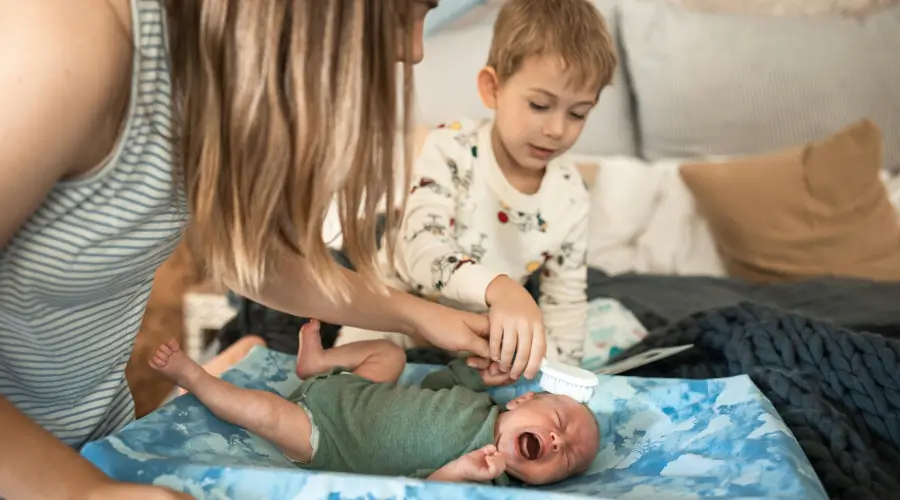settings
children
With Famly since
When it comes to milestones in early childhood, speech and language milestones are complex. There’s so much more to speech and language development than just a number of words or a simple “yes” or “no” response to the common question, “Is your child talking?”
Let me explain…

All behavior is a form of communication
As a pediatric speech-language pathologist, a question I like to start off with during an evaluation is “How does your child communicate their wants and needs?” I prefer to ask this question because all behavior is communication.
Human beings communicate from birth (by crying!), and by phrasing the question in this way, it usually results in a more insightful answer that gives me a true picture of that child’s overall communication skills.
What are pre-linguistic skills?
Before a child uses words to speak, they will use what we call “pre-linguistic skills,” or what I like to call “pre-talking skills.”
One of the first things I look for during an evaluation is joint attention. This is a child’s ability to purposefully attend to either their conversational partner, or another object nearby. This demonstrates the ability to share their common focus with the other individual.
Joint attention does not require any spoken language and gives insight into a child’s social skills, awareness and nonverbal communication skills. More often than not, a child will communicate without words by either pointing, showing an item, or smiling and making eye-contact.
All of these are pre-talking skills!
Other pre-talking skills include using gestures, babbling, using eye contact, understanding words, imitating actions, responding to others and more. This is all a part of typical speech and language development.
So simply put, pre-linguistic skills, or pre-talking skills, are the foundation of language. and mastering these skills sets a child up for successful word formation.

The big ideas
What does word count really mean?
Although many people acknowledge that word count is a typical milestone that is looked at for “normal” speech and language development, not everyone knows what actually counts as a word.
Children do not start speaking in a manner that is able to be 100% understood. Thus, it is common for babies and toddlers to exhibit common toddler speech errors, like:
- Syllable reduction: saying only part of a word
- Final consonant deletion: leaving the endings off words
Because of this, words that are “worth counting” are any that are said consistently, independently (not in imitation), and purposefully (like to request or label an item).
For example, if a child sees a dog walking across the street and says “da” totally unprompted while looking at it, this would count as a word assuming it happens fairly consistently. It was said independently and the purpose is that the child wanted to label or name the dog. We are not worried about the “G” sound, or perfect pronunciation, as a child begins to talk!
There is more to communication than word count
Because there is more to assessing a child’s language skills than simply looking at the number of words a child is using, we must look at their ability to use different communication functions.
I described the function of labeling above, but some other communication functions are:
- Requesting items, assistance (“help!”) or attention (“look!”)
- Using social greetings (“hi” or “bye”)
- Protesting (“no!” or “stop!”),
- Terminating (“all done”)
- Describing
- Asking or answering questions
- Commenting (usually starts as a “mmm” or “wow” at first)
- Expressing feelings
"If I’m working with a child who has a great vocabulary and is able to label a lot of nouns, while their word count may be 'within the average range' for their age, their communication isn’t very functional if they aren’t able to ask for what they want or need, ask for help, answer a yes or no question, and more. This is why I always say there is more to language skills than word count!"

Set communication goals besides increasing word count
When I am working with a young toddler in early intervention, most of the goals that we are targeting in speech-language therapy has to do with getting that child to use more communication functions!
Instead of focusing on increasing that child’s number of words, here are examples of some of the goals that we target:
- Billy will use gestures or words to request a snack or preferred activity at least 5x a day.
- Billy will use gestures or words to protest (ex: “No!” Or “stop!”) instead of hitting or pushing at least 3x a day, as reported by his mom or daycare teacher.
- Billy will use yes and no responses to accept and reject preferred and non-preferred items or activities at least 5x a day.
- Billy will use a word to terminate (“all done”) during mealtimes and activities.
With all that said, if you are ever wondering if your child’s communication skills are where they should be for their age, it’s important to schedule a speech-language evaluation with a licensed speech-language pathologist. This can be done through your state’s early intervention program or at a local outpatient clinic or private practice.
Leave language barriers behind
Bring your multilingual community closer with an in-app live translation tool with over 130 languages.
Learn how live translation works









